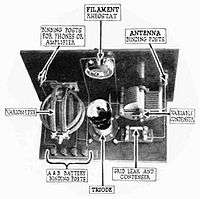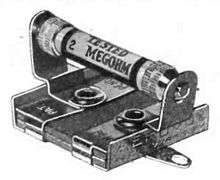Grid-leak detector



A grid-leak detector is a thermionic valve (UK, Australia, NZ etc.), or vacuum tube (USA), circuit used in older vacuum tube AM radio receivers, which served as a combination amplifier and detector (rectifier) to extract the audio signal from the modulated radio frequency signal. The tube used a grid leak circuit to generate the DC grid bias voltage necessary for proper operation from grid current that occurs in all vacuum tubes due to electrons attracted to the grid during the positive part of the RF cycle.
History

The heyday for grid-leak detectors was the 1920s, when battery-operated, multi-dial tuned radio frequency receivers using low-mu triodes with directly heated cathodes were the norm. The Zenith Models 11, 12, and 14 are examples of these kinds of radios.[1] When indirectly heated cathodes and AC powered receivers were introduced in 1927, most manufacturers switched to plate detectors, and later to diode detectors.
Although the regenerative grid-leak detector was one of the more sensitive detectors of its day, its ability to radiate radio frequency energy when improperly adjusted limited its use in urban settings where multiple receivers would be operated in close proximity. The RCA Radiola III and IIIa and the Crosley Model 51 are examples of regenerative receivers from this period.
Grid leak bias
A valve has a resistor connected from grid to ground, typically as the only bias component. Thus grid leak current is used to bias the valve. Resistors in the region of 1 Megohm were common.
When the grid leak stage had a transformer input, the valve grid connected to one end of the transformer secondary, and the other end of the secondary went to ground via the grid leak resistor and a small bypass capacitor.
The use of grid leak bias competed with use of a so-called C battery for providing a fixed negative voltage on the grid. When vacuum tubes came to be constructed with cathodes electrically isolated from their filaments, it became possible to use cathode biasing. This involved use of a resistor from the cathode to ground, which provides better control of anode current through negative feedback. This method also requires a relatively large capacitor across the cathode resistor to avoid losing AC gain (through negative feedback), and the cost of a sufficiently sized capacitor was an issue in the pre-war years, as capacitors had low capacity per volume and per cost.
Grid leak detector
The grid leak detector was in common use in the 1920s and 30s in radio receivers. The grid leak detector stage is a non-linear valve amplifier. The grid bias produced by the grid leak across the biassing grid leak resistor, plus the typically non-linear characteristic of the valves chosen, result in a non-linear rf amplifying stage. The stage performs two, or more often three functions:
- Detection: The nonlinearity of the grid in the stage produces an audio frequency detected component in the anode load.
- Amplification: The stage amplifies the RF plus audio at the grid,[2] thus it gives much better sensitivity than a diode detector.
- Reaction: In most cases a small amount of positive feedback was added to give reaction (aka regeneration) to boost RF sensitivity, selectivity and often output volume. The term "reaction" means the same as "regeneration", but "reaction" is more common in British usage.
In simple one-valve sets, the grid leak detector directly drove the headphones, since it produced enough audio frequency output from local (and some distant) stations as well as radio frequency. In better sets, the grid leak detector's output fed - after filtering out the RF - an audio amplifying valve, or occasionally more than one.
Operation
In the circuit, the grid of the detector (usually a low-mu or medium-mu triode) is connected to the secondary of the final RF or IF transformer through a capacitor, the "grid leak capacitor" of 100 pF to 330 pF, with 250 pF being typical. A large resistor, the "grid leak resistor" of a few hundred kΩ to 10 MΩ is connected either in parallel with this capacitor, or from the detector's grid to ground. The resistor-capacitor combination, in concert with the nearly unidirectional current flow of the detector's grid-to-cathode (or grid-to-filament, if it's directly heated) circuit, forms a clamp circuit. The incoming modulated radio frequency signal voltage swings both positive and negative with respect to ground as it emerges from the final RF or IF stage. The detector's grid-to-cathode circuit will only conduct current when the grid is positive with respect to the cathode. The resulting current flow charges the capacitor to maintain a voltage which biases the detector grid negative with respect to its cathode. The amount of bias varies based on the received signal strength. The grid leak resistor - capacitor circuit is designed to have a time constant which is slightly slower than the rate of change of the audio program and much slower than the rate of change of the carrier. Because the bias varies depending on signal strength, plate current will rise on very low signals, and operation near cut-off of the tube will cause distortion. On receivers with battery powered heaters, the heater power supply could be used to bias the tube with a small positive voltage.[3] The nearly unidirectional current flow of the received, modulated signal results in a separate audio signal that is said to be detected or demodulated. The triode detector tube also amplifies this audio signal, thereby providing two processes in one tube. Regenerative detectors often used grid leak, especially in the detection of amplitude modulated signals.
The grid leak detector circuit output, often taken from the plate of the detector tube, may require additional filtering to remove remnants of the carrier portion of the received signal. RF chokes and/or capacitors may be employed.
Advantages
A grid-leak detector provides demodulation as well as amplification of the audio signal, unlike a classical diode/crystal detector.
Disadvantages
One potential disadvantage of the grid leak detector is that the input impedance of the detector may be affected by the need to self bias the detector tube with grid current. Having the grid leak resistor, even in the Megohm range, shunting signal to ground loads the received signal. Although this may be mitigated to some degree by taking the resistor to the top of the tuned circuit (i.e. in parallel with the capacitor) and through the coil to earth, or by circuit design and component optimization, forward grid current will still load the input signal (and reduce the Q of the tuned circuit). Plate detectors have the advantage in that they isolate the detector load from the input circuit more effectively and may be employed where sensitivity is thought to be otherwise compromised by a grid leak or diode detector circuit.
See also
References
- ↑ Schematics of Zenith models 11, 12 and 14. Three battery-operated Zenith grid-leak models of the 1920s.
- ↑ "8". The Radio Amateur's Handbook (55 ed.). The American Radio Relay League. 1978. p. 241.
- ↑ Radiotron Designers Handbook, 4th Edition, pp. 1082-1084
- Rutland, David (September 1994), Behind the Front Panel: The Design & Development of 1920's Radios, Wren, ISBN 978-1885391001
- Schematic of Philco model 84 A superheterodyne cathedral radio from 1933 that uses a regenerative detector. (Note: The capacitor for the detector's control grid is the "tickler coil" winding on the IF transformer.)